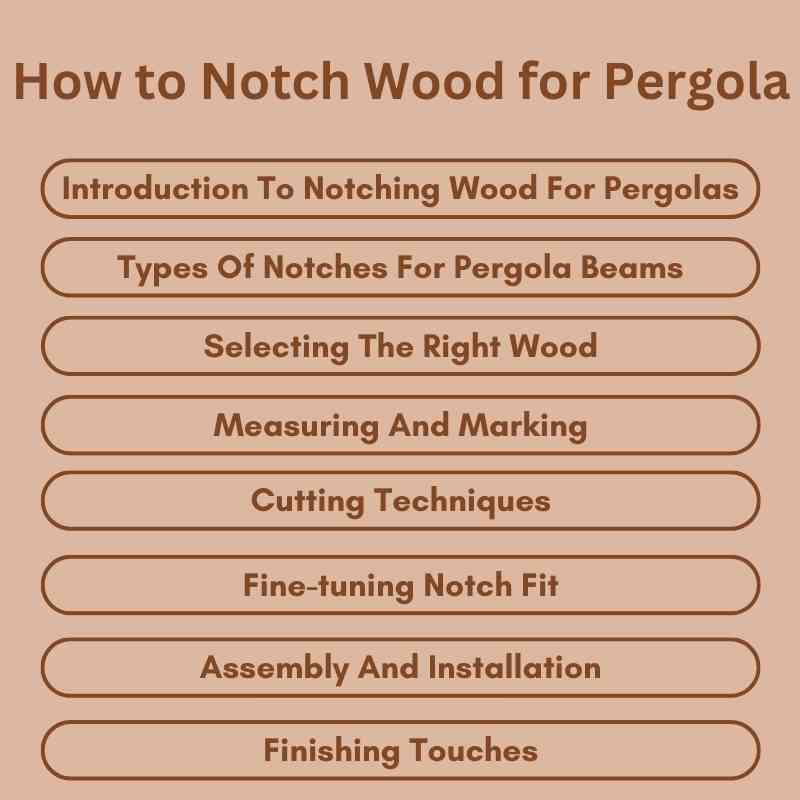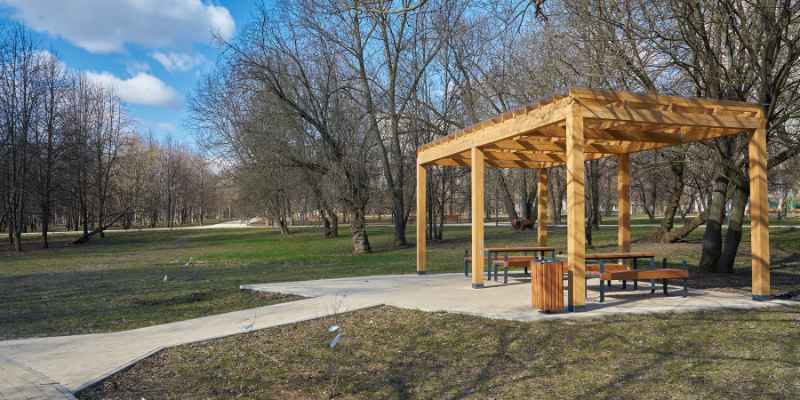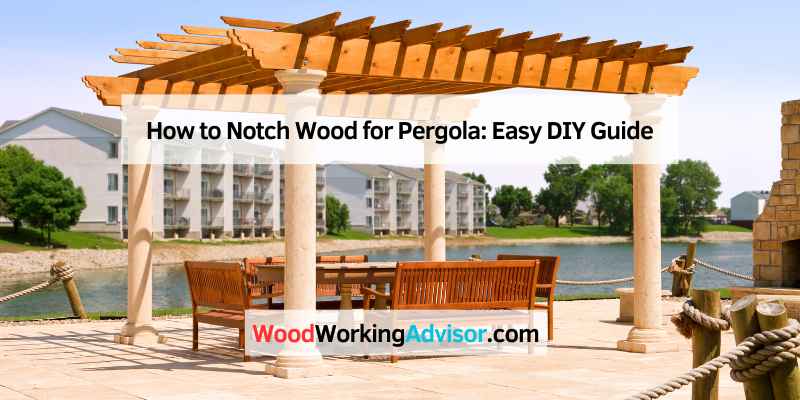To notch wood for a pergola, measure and mark the desired dimensions on the beam. Use a saw to cut along the marked lines, ensuring a clean and precise notch.
Building a pergola can enhance your outdoor space, providing shade and an inviting atmosphere. Notching the wood correctly is essential for structural integrity and aesthetics. Proper notching allows beams to fit together securely, creating a stable framework. Whether you’re a seasoned carpenter or a DIY enthusiast, understanding the notching process is crucial.
This guide will walk you through the steps, ensuring your pergola is both beautiful and functional. With the right techniques, you’ll achieve a professional look while enjoying the satisfaction of building it yourself. Let’s explore the best methods for notching wood effectively.
Introduction To Notching Wood For Pergolas
Notching wood for pergolas has many benefits. It creates stronger joints, which improve stability. Notching allows for better weight distribution. This helps the structure last longer.
Using notches also adds to the aesthetic appeal. It gives pergolas a neat and professional look. Notched wood can fit together more securely than flat pieces. This makes construction easier and faster.
Essential tools for notching include:
| Tool | Purpose |
|---|---|
| Chisel | For carving out notches |
| Saw | To cut the wood accurately |
| Measuring tape | To measure dimensions correctly |
| Square | For ensuring right angles |
| Sandpaper | To smooth the edges |

Types Of Notches For Pergola Beams
The Half-Lap Notch is a popular choice. It allows two beams to intersect. This notch creates a strong connection. It is easy to cut and fit.
V Notches are great for angled beams. They create a clean look. Use them for a modern design. This notch offers good stability.
Birdsmouth Notches are ideal for rafters. They fit snugly onto the top beam. This notch helps distribute weight well. It is essential for safety and strength.
Selecting The Right Wood
Choosing the right wood is essential for a strong pergola. Wood needs to resist moisture and insects. Some woods can warp or decay quickly. Cedar and redwood are naturally resistant to these issues. They also look great outdoors.
Pressure-treated pine is another option. It is affordable and durable. Make sure to use a high-quality sealant. This helps protect the wood from the elements.
| Wood Type | Benefits |
|---|---|
| Cedar | Natural resistance to decay and insects |
| Redwood | Beautiful appearance and durability |
| Pressure-Treated Pine | Cost-effective and long-lasting with sealing |
Measuring And Marking
To create a strong notch for your pergola, start with accurate measurements. Use a tape measure to find the right dimensions. Make sure to double-check all numbers to avoid mistakes.
Next, mark the wood clearly. Use a pencil for visible lines. Ensure your marks are straight and easy to see. This helps to cut correctly later.
For calculating notch dimensions, remember to consider the thickness of the wood. The notch should fit snugly around beams. Take your time to ensure every measurement is precise.
After marking, use a square to create right angles. This will guide your cuts and ensure clean edges. A sharp saw will make the cutting easier and neater.
Cutting Techniques
Hand sawing offers great control for precise cuts. Use a fine-toothed saw for clean edges. Take your time to ensure accuracy.
Using a chisel is perfect for making clean cuts in wood. Choose a sharp chisel for better results. Always work with a steady hand.
Power tools save time and effort when notching wood. A router can create smooth notches quickly. Make sure to follow safety guidelines while using them.
Fine-tuning Notch Fit
To achieve a perfect notch fit, start with sanding. Smooth edges make the fit better. Use fine-grit sandpaper to avoid rough spots. This step is crucial for a clean look.
Next, perform a test fit. Place the wood pieces together to check alignment. Look for gaps or misalignments. Make adjustments as necessary to ensure a snug fit.
Repeat sanding and fitting until satisfied. This method saves time and effort later. A well-fitted notch enhances the overall appearance of your pergola.
Assembly And Installation
Securing notched beams together is essential for a strong pergola. Use metal brackets to hold the beams tightly. This helps prevent any movement or shifting. Make sure all screws are tightened properly.
Mounting the pergola structure requires careful planning. Start by aligning the beams correctly. Use a level to ensure everything is straight. Secure each beam to the posts with heavy-duty screws. This will provide great support.
Consider using wood glue for extra strength. It can fill small gaps and improve stability. Always double-check your work before moving on. A well-mounted pergola will last longer and look better.
Finishing Touches
Sealing wood is important for protecting your pergola. Use a high-quality sealant to prevent moisture damage. Apply the sealant evenly with a brush or sprayer. Let it dry completely before adding any decorations.
Decorative enhancements can make your pergola stand out. Consider using outdoor lighting to create a cozy atmosphere. Hanging plants or flowers can add color and life. Choose fabrics for curtains or cushions that are weather-resistant.
| Enhancement | Benefit |
|---|---|
| Outdoor Lighting | Creates a warm and inviting space. |
| Hanging Plants | Adds natural beauty and charm. |
| Weather-Resistant Fabrics | Ensures durability and comfort. |
Maintenance And Upkeep
Regular inspection keeps your pergola looking great. Check for any signs of damage or wear. Look for cracks, splinters, or loose joints. Repair these issues quickly to prevent further damage.
Weather can harm wood. Rain, sun, and snow cause wear over time. Use a protective sealant to guard against moisture. This helps to keep the wood strong and beautiful. Check the sealant every few years and reapply as needed.
Clean the wood regularly. Dirt and debris can cause mold or fungus to grow. A gentle wash with soap and water will help maintain its appearance.
Safety Precautions
Always wear safety goggles to protect your eyes. Use ear protection if tools are loud. Gloves can help prevent cuts and scrapes. A dust mask is useful for respiratory protection.
Check all tools before use. Ensure they are in good condition. Use tools for their intended purpose only. Keep your workspace clean and organized. This reduces the risk of accidents.
Store materials safely to prevent tripping hazards. Lift heavy items correctly to avoid injury. Always ask for help with large pieces. Be aware of your surroundings while working.

Frequently Asked Questions
How Do I Notch Wood For A Pergola?
Notching wood for a pergola involves creating a cutout to allow beams to fit securely. Use a circular saw for precise cuts, ensuring the notches align correctly. Mark the dimensions clearly before cutting to avoid mistakes. Always wear safety gear when using power tools for protection.
What Tools Are Needed For Notching Wood?
Essential tools for notching wood include a circular saw, chisels, and a measuring tape. A square can help ensure right angles. Additionally, a level is useful for checking alignment. Having a hammer and safety goggles on hand is also recommended for accuracy and protection.
What Is The Best Wood For A Pergola?
Cedar, redwood, and pressure-treated pine are ideal for pergolas. Cedar and redwood naturally resist decay and insects, enhancing durability. Pressure-treated pine is cost-effective and can withstand various weather conditions. Choose wood based on your budget and desired aesthetic for your outdoor space.
How Deep Should Pergola Notches Be?
Notches on pergola beams should typically be one-third the thickness of the wood. This depth ensures structural integrity while allowing for a snug fit. Measure carefully to maintain uniformity across all notches. Consistency is key to achieving a professional look and ensuring stability.
Conclusion
Notching wood for your pergola enhances its strength and aesthetics. This simple technique allows for better support and a more polished look. By following the steps outlined, you can achieve professional results. Enjoy the process and take pride in your craftsmanship.
A well-notched pergola will elevate your outdoor space beautifully.

